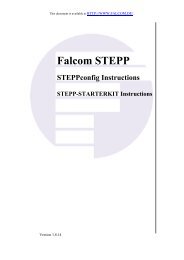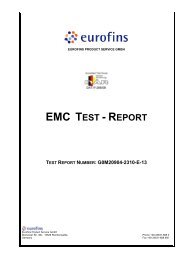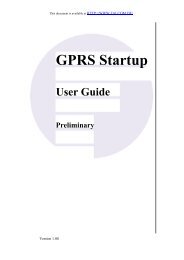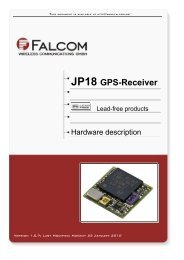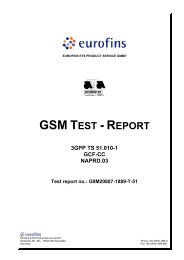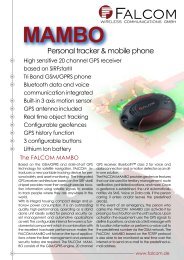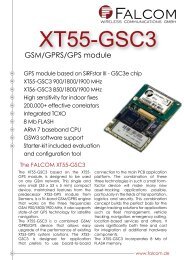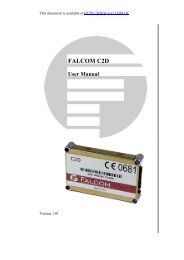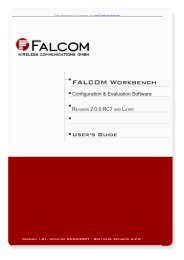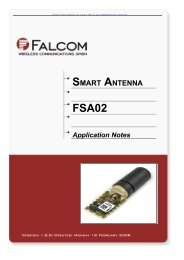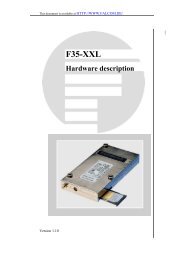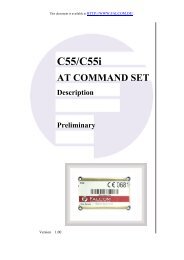4 hardware interfaces - Falcom
4 hardware interfaces - Falcom
4 hardware interfaces - Falcom
Create successful ePaper yourself
Turn your PDF publications into a flip-book with our unique Google optimized e-Paper software.
.<br />
THIS DOCUMENT IS AVAILABLE AT HTTP://WWW.FALCOM.DE/<br />
DR864<br />
HARDWARE MANUAL<br />
Version: 1.0.2; Last Modified: Monday 8 November 2010
DR864 HARDWARE MANUAL VERSION 1.0.2<br />
Version history:<br />
This table provides a summary of the document revisions.<br />
Number Author Changes Modified<br />
-<br />
1.0.2 F. Beqiri - Added power consumption - see chapter 3.2. 08/11/2010<br />
1.0.1 F. Beqiri - Added hosing dimensions - see chapter 5. 18/10/2010<br />
1.0.0 F. Beqiri - Initial version. 15/01/2010<br />
This confidential document is a property of FALCOM and may not be copied or circulated without previous permission.<br />
Page 2 of 23
DR864 HARDWARE MANUAL VERSION 1.0.2<br />
Cautions<br />
Information furnished herein by FALCOM is believed to be accurate and reliable. However, no<br />
responsibility is assumed for its use. It is necessary to read this manual before you start using the<br />
device.<br />
Please, read carefully the safety precautions.<br />
If you have any technical questions regarding this document or the product described in it, please<br />
contact your vendor.<br />
General information about FALCOM and its range of products are available at the following<br />
Internet address: http://www.falcom.de/<br />
Trademarks<br />
Some mentioned products are registered trademarks of their respective companies.<br />
Copyright<br />
This document is copyrighted by FALCOM WIRELESS COMMUNICATIONS GmbH with all rights reserved.<br />
No part of this documentation may be produced in any form without the prior written permission<br />
of FALCOM WIRELESS COMMUNICATIONS GmbH.<br />
FALCOM WIRELESS COMMUNICATIONS GmbH.<br />
No patent liability is assumed with respect to the use of the information contained herein.<br />
Note<br />
Specifications and information given in this document are subject to change by FALCOM without<br />
notice.<br />
This confidential document is a property of FALCOM and may not be copied or circulated without previous permission.<br />
Page 3 of 23
DR864 HARDWARE MANUAL VERSION 1.0.2<br />
Table of contents<br />
1 INTRODUCTION.................................................................................5<br />
1.1 General......................................................................................................................5<br />
1.2 Used abbreviations..................................................................................................6<br />
1.3 Related documents..................................................................................................7<br />
2 SECURITY.......................................................................................8<br />
2.1 General information.................................................................................................8<br />
2.2 Exposure to RF energy............................................................................................8<br />
2.3 Driving.......................................................................................................................9<br />
2.4 Electronic devices....................................................................................................9<br />
2.5 Vehicle electronic equipment..................................................................................9<br />
2.6 Medical electronic equipment.................................................................................9<br />
2.7 Aircraft.......................................................................................................................9<br />
2.8 Children.....................................................................................................................9<br />
2.9 Blasting areas...........................................................................................................9<br />
2.10 Potentially explosive atmospheres....................................................................10<br />
2.11 Safety standards..................................................................................................10<br />
3 TECHNICAL DATA............................................................................11<br />
3.1 Technical specifications of GSM/GPRS engine..................................................11<br />
3.2 Power consumption for DR864.............................................................................13<br />
3.3 Operating temperatures.........................................................................................13<br />
3.4 Determining the External Equipment Type..........................................................13<br />
4 HARDWARE INTERFACES...................................................................14<br />
4.1 Getting started........................................................................................................14<br />
4.1.1 Hardware & software requirements....................................................................14<br />
4.1.2 Minimum <strong>hardware</strong> interface to get started........................................................14<br />
5 HOUSING......................................................................................22<br />
6 RF EXPOSURES............................................................................23<br />
This confidential document is a property of FALCOM and may not be copied or circulated without previous permission.<br />
Page 4 of 23
DR864 HARDWARE MANUAL VERSION 1.0.2<br />
1 INTRODUCTION<br />
This product manual is only addressed to qualified personnel which are well skilled in<br />
electronical/electrical installation and not addressed to private consumers/end users. The installation,<br />
implementing or setting into operation of the product can only be performed by qualified personnel.<br />
1.1 General<br />
The DR864 is a Quad-Band GSM/GPRS engine that allows communication on any GSM network in<br />
the world. It works on four frequencies GSM 850/900 MHz, DCS 1800 MHz and PCS 1900 MHz. The<br />
product is built inside a single DIN rail housing for easy mounting. To cover the need of high speed<br />
data transfers and the use of real time TCP/IP orientated applications it has an embedded TCP/IP<br />
enabled GSM/GPRS modem. The configuration can be done through the RS232 interface (Rx, Tx)<br />
using AT-commands. To monitor the status of the GSM/GPRS engine there is a LED status indicator<br />
on the top panel of the device housing. The GSM/GPRS engine inside the product is a Telit GE-864-<br />
PY Quad module with embedded GE-864-PY (Python) Script Interpreter allowing self controlled<br />
operation of the modem. This allows system integrators or end users to run own python script<br />
codes, for example: send SMS notifications, set the provided GPIO to a specific level and set up a<br />
permanent TCP connection to a remote server socket, for example, when connecting to a fuse<br />
panel for controlling automatically or remotely the light of the house, or something of user<br />
interest. The DIN Rail housing, embedded GE-864-PY Script Interpreter, wide range DC power<br />
supply from 10.8 ... 31.2 VDC and wide operating temperature from -30 to + 80 °C make the DR864<br />
product suitable for the most demanding industrial applications. The product provides 1 GPIO pin,<br />
a RS232 interface and power supply lines. The product features GPRS class B, class 10 (making<br />
download at speeds up to 85 kbps) and supports GPRS coding schemes CS-1, CS-2, CS-3 and CS-4.<br />
To control the functions of the GSM module there is an advanced set of the AT commands<br />
according to GSM ETSI (European Telecommunications Standards Institute) 07.07 and 07.05<br />
implemented. Additionally the "AT Command Set" manual for this modem is also available for free<br />
download from the FALCOM's product page at: www.falcom.de.<br />
About GPRS:<br />
GPRS is standard for General Packet Radio Service that is an add-on to the GSM (Global System for<br />
Mobile Communications) cellular network - a type of network used to provide cellular phone service. In<br />
regions where GPRS is not available, users can still access their important information with GSM 14.4<br />
kbps data connections.<br />
Users are advised to quickly proceed to the “Security” chapter and read the hints carefully.<br />
This confidential document is a property of FALCOM and may not be copied or circulated without previous permission.<br />
Page 5 of 23
DR864 HARDWARE MANUAL VERSION 1.0.2<br />
1.2 Used abbreviations<br />
Abbreviation Description<br />
CHAP Challenge Handshake Authentication Protocol<br />
CPU Central Processing Unit<br />
CS Coding Scheme<br />
CSD Circuit Switched Data<br />
DCE Data Communication Equipment (typically modems, e.g. XF55-AVL GSM engine)<br />
DCS 1800 Digital Cellular System, also referred to as PCN<br />
DSR Data Set Ready<br />
DTE Data Terminal Equipment (typically computer or, for example, GSM application)<br />
DTR Data Terminal Ready<br />
EGSM Enhanced GSM<br />
ESD Electrostatic Discharge<br />
GPRS General Packet Radio Service<br />
GSM Global Standard for Mobile Communications<br />
IMEI International Mobile Equipment Identity<br />
kbps kbits per second<br />
PCS Personal Communication System, also referred to as GSM 1900<br />
PDU Protocol Data Unit<br />
PPP Point-to-point protocol<br />
Rx Receive Direction<br />
SIM Subscriber Identification Module<br />
SMS Short Message Service<br />
Tx Transmit Direction<br />
FD SIM fix dialing phonebook<br />
LD SIM last dialing phonebook (list of numbers most recently dialed)<br />
ME Mobile Equipment phonebook<br />
SM SIM phonebook<br />
This confidential document is a property of FALCOM and may not be copied or circulated without previous permission.<br />
Page 6 of 23
DR864 HARDWARE MANUAL VERSION 1.0.2<br />
1.3 Related documents<br />
Some other PDF documents such as FCC approval, application notes, Certificate of Conformity<br />
R&TTE etc. are available on the Web at: http://www.falcom.de/ in the published download area.<br />
NR PDF file name Description<br />
[1] gprs_startup_user_guide.pdf Contains the description of the internal firmware and the supported<br />
Configuration Command Set for the DR864.<br />
[2] Telit_AT_Commands_Reference_Guide.pdf Contains the description of the supported AT Commands Set for the Telit<br />
module GE864-QUAD inside the DR864 modem.<br />
[3] Telit_Easy_Script_Python_r1xx.pdf Gives an overview of the Easy Script Extension feature, which lets the<br />
developer to control the modem, by writing application directly in a high level<br />
language such as Python.<br />
These PDF files are viewable and printable from Adobe Reader. If you do not have the Adobe Reader installed,<br />
you can download it from http://www.adobe.com.<br />
This confidential document is a property of FALCOM and may not be copied or circulated without previous permission.<br />
Page 7 of 23
DR864 HARDWARE MANUAL VERSION 1.0.2<br />
2 SECURITY<br />
IMPORTANT FOR THE EFFICIENT AND SAFE OPERATION OF YOUR GSM-MODEM, READ THIS<br />
INFORMATION BEFORE USE!<br />
Your cellular engine DR864 is one of the most exciting and innovative electronic products ever<br />
developed. With it, you can stay in contact with your office, your home, emergency services and<br />
others, wherever service is provided.<br />
This chapter contains important information for the safe and reliable use of the DR864 device.<br />
Please read this chapter carefully before starting to use the cellular engine DR864.<br />
2.1 General information<br />
Your DR864 device utilizes the GSM standard for cellular technology. GSM is a newer radio<br />
frequency („RF“) technology than the current FM technology that has been used for radio<br />
communications for decades. The GSM standard has been established for use in the European<br />
community and elsewhere. Your DR864 is actually a low power radio transmitter and receiver. It<br />
sends out and receives radio frequency energy. When you use your modem, the cellular system<br />
handling your calls controls both the radio frequency and the power level of your cellular modem.<br />
SIM cards are needed for the use of the acquired devices, which are not included in the scope of<br />
delivery of the device. The SIM cards can be acquired e.g. by specific providers. Additional costs can<br />
result from the use of the SIM cards which are to be borne by the purchaser (client) of the devices.<br />
The seller does not cover the extra costs for the use of the devices. The seller gives no<br />
recommendation for the use of specific SIM cards and is not liable for the fact that the devices are<br />
usable with all available SIM cards. The seller is also not liable for any other costs that are needed<br />
for the application of the customer in connection with this device.<br />
2.2 Exposure to RF energy<br />
There has been some public concern about possible health effects of using GSM modems. Although<br />
research on health effects from RF energy has focused for many years on the current RF<br />
technology, scientists have begun research regarding newer radio technologies, such as GSM. After<br />
existing research had been reviewed, and after compliance to all applicable safety standards had<br />
been tested, it has been concluded that the product is fit for use.<br />
If you are concerned about exposure to RF energy, there are things you can do to minimize<br />
exposure. Obviously, limiting the duration of your calls will reduce your exposure to RF energy. In<br />
addition, you can reduce RF exposure by operating your cellular modem efficiently by following the<br />
guidelines below.<br />
2.3 Driving<br />
Check the laws and regulations on the use of cellular devices in the area where you drive. Always<br />
obey them. Also, when using your DR864 while driving, please pay full attention to driving, pull off<br />
the road and park before making or answering a call if driving conditions so require. When<br />
applications are prepared for mobile use, they should fulfil road-safety instructions of the current<br />
law!<br />
This confidential document is a property of FALCOM and may not be copied or circulated without previous permission.<br />
Page 8 of 23
DR864 HARDWARE MANUAL VERSION 1.0.2<br />
2.4 Electronic devices<br />
Most electronic equipment, for example in hospitals and motor vehicles is shielded from RF<br />
energy. However, RF energy may affect some malfunctioning or improperly shielded electronic<br />
equipment.<br />
2.5 Vehicle electronic equipment<br />
Check your vehicle manufacturer’s representative to determine if any on board electronic<br />
equipment is adequately shielded from RF energy.<br />
2.6 Medical electronic equipment<br />
Consult the manufacturer of any personal medical devices (such as pacemakers, hearing aids, etc.)<br />
to determine if they are adequately shielded from external RF energy.<br />
Turn your DR864 device OFF in health care facilities when any regulations posted in the area<br />
instruct you to do so. Hospitals or health care facilities may be using RF monitoring equipment.<br />
2.7 Aircraft<br />
Turn your DR864 OFF before boarding any aircraft. Use it on the ground only with crew permission.<br />
Do not use it in the air.<br />
To prevent possible interference with aircraft systems, Federal Aviation Administration (FAA)<br />
regulations require you to have permission from a crew-member to use your modem while the<br />
plane is on the ground. To prevent interference with cellular systems, local RF regulations prohibit<br />
using your modem whilst airborne.<br />
2.8 Children<br />
Do not allow children to play with your DR864 device. It is not a toy. Children could hurt<br />
themselves or others (by poking themselves or others in the eye with the antenna, for example).<br />
Children could damage the modem or make calls that increase your modem bills.<br />
2.9 Blasting areas<br />
To avoid interfering with blasting operations, turn your device OFF when in a “blasting area” or in<br />
areas posted: „turn off two-way radio“. Construction crew often uses remote control RF devices to<br />
set off explosives.<br />
2.10 Potentially explosive atmospheres<br />
Turn your DR864 device OFF when in any area with a potentially explosive atmosphere. It is rare, but<br />
your modems or their accessories could generate sparks. Sparks in such areas could cause an explosion<br />
or fire resulting in bodily injury or even death.<br />
Areas with a potentially explosive atmosphere are often, but not always, clearly marked. They<br />
include fuelling areas such as petrol stations; below decks on boats; fuel or chemical transfer or<br />
storage facilities; and areas where the air contains chemicals or particles, such as grain, dust or<br />
metal powders.<br />
Do not transport or store flammable gas, liquid or explosives, in the compartment of your vehicle,<br />
which contains your modem or accessories.<br />
This confidential document is a property of FALCOM and may not be copied or circulated without previous permission.<br />
Page 9 of 23
DR864 HARDWARE MANUAL VERSION 1.0.2<br />
Before using your modem in a vehicle powered by liquefied petroleum gas (such as propane or<br />
butane) ensure that the vehicle complies with the relevant fire and safety regulations of the<br />
country in which the vehicle is to be used.<br />
2.11 Safety standards<br />
Your GSM/GPRS device complies with all applicable RF safety standards.<br />
DR864 meets the safety standards for RF receivers and the standards and recommendations for<br />
the protection of public exposure to RF electromagnetic energy established by government bodies<br />
and professional organizations, such as directives of the European Community, Directorate General<br />
V in matters of radio frequency electromagnetic energy.<br />
This confidential document is a property of FALCOM and may not be copied or circulated without previous permission.<br />
Page 10 of 23
DR864 HARDWARE MANUAL VERSION 1.0.2<br />
3 TECHNICAL DATA<br />
3.1 Technical specifications of GSM/GPRS engine<br />
� Power supply:<br />
� Power consumption:<br />
➢ Supply voltage in range of 10.8 ... 31.2 VDC ±5 %<br />
➢ See chapter 3.2.<br />
� Extended Temperature Range:<br />
� Physical characteristics of modem:<br />
� RoHS Compliance:<br />
� Mounting:<br />
� Frequency bands:<br />
� Transmit power:<br />
� GPRS connectivity:<br />
� DATA: GPRS ⇒<br />
CSD ⇒<br />
➢ - 30 °C to + 80 °C (see chapter 3.3 for further details)<br />
➢ Size: 86.0 ± 0.15 mm x 65.0 ± 0.15 mm x 27.0 ± 0.15 mm (for more details<br />
see chapter 5 “Housing”)<br />
➢ Weight: 28 ± 2 g (with FME connector)<br />
➢ Comply with RoHS directive of the European Union<br />
➢ Easy snap-on assembly onto DIN-rails with a installation width of 35 mm<br />
according EN50 022.<br />
➢ Quad-band: 850/900/1800/1900<br />
➢ Compliant to GSM Phase 2/2+<br />
➢ Class 4 (2 W) at GSM850/900<br />
➢ Class 1 (1 W) at GSM 1800/1900<br />
➢ GPRS mobile station class B, multi-slot class 10.<br />
➢ GPRS data downlink transfer: max. 85.6 kbps (see table 1).<br />
➢ GPRS data uplink transfer: max. 42.8 kbps (see table 1).<br />
➢ Coding scheme: CS-1, CS-2, CS-3 and CS-4.<br />
➢ Supports two protocols PAP (Password Authentication Protocol) and CHAP<br />
(Challenge Handshake Authentication Protocol) commonly used for PPP<br />
connections.<br />
➢ Support of Packet Switched Broadcast Control Channel (PBCCH) allows you<br />
to benefit from enhanced GPRS performance when offered by the network<br />
operators.<br />
➢ Support TCP/IP stack access via AT commands<br />
➢ Asynchronous transparent Circuit Switched Data (CSD), up to 14,4 kbps<br />
➢ Asynchronous non-transparent CSD up to 9,6 kbps,<br />
➢ V.110.<br />
This confidential document is a property of FALCOM and may not be copied or circulated without previous permission.<br />
Page 11 of 23
DR864 HARDWARE MANUAL VERSION 1.0.2<br />
� SMS:<br />
� SIM interface:<br />
� Housing:<br />
� Antenna:<br />
� Serial interface (RS232C):<br />
� Phonebook management:<br />
➢ MT, MO, CB, Text and PDU mode.<br />
➢ SMS storage: SIM card + in the mobile equipment.<br />
➢ Supported SIM card: 3/1.8 V.<br />
➢ Built-in SIM Card Holder (for small SIM card, only).<br />
➢ Badamid® B70 GF30 FR HF (Badamid PA6-based materials - Polyamide 6<br />
(PA6), additives, 30% glass fibres).<br />
➢ External antenna cable<br />
➢ Cable length: RG 174 233 mm (± 2 mm) with a 50 Ohm FME female<br />
➢ Serial link↔full-featured 4-wire (RX, TX, RTS, CTS) serial interface for AT<br />
commands and data.<br />
➢ Baud rate: 300 bps ... 230 kbps (default = 9600 bps)<br />
➢ Supported phonebook types: SM, FD, LD, MC, RC, ON, ME<br />
Coding scheme 1 Timeslot 2 Timeslots 4 Timeslots<br />
CS-1: 9.05 kbps 18.1 kbps 36.2 kbps<br />
CS-2: 13.4 kbps 26.8 kbps 53.6 kbps<br />
CS-3: 15.6 kbps 31.2 kbps 62.4 kbps<br />
CS-4: 21.4 kbps 42.8 kbps 85.6 kbps<br />
Table 1: Coding schemes and maximum net data rates over air interface<br />
Please note that the values listed above are the maximum ratings which, in practice, are influenced by a great<br />
variety of factors, primarily, for example, traffic variations and network coverage.<br />
3.2 Power consumption for DR864<br />
POWER CONSUMPTION (Average supply current )<br />
Min. Typ. Max. Unit Description<br />
Supply voltage 10.8 12 32 V<br />
GSM<br />
Voltage must stay within the min/max values, including voltage drop, ripple<br />
and spikes.<br />
14.7 mA Module registered on the network and can receive voice call or an SMS.<br />
60<br />
49<br />
98<br />
95<br />
mA IDLE mode<br />
mA Data mode<br />
MODE BAND<br />
EGSM 900<br />
GSM 1800/1900<br />
EGSM 900 *)<br />
GSM 1800/1900 **)<br />
This confidential document is a property of FALCOM and may not be copied or circulated without previous permission.<br />
Page 12 of 23
GPRS<br />
DR864 HARDWARE MANUAL VERSION 1.0.2<br />
62<br />
48<br />
102<br />
86<br />
POWER CONSUMPTION (Average supply current )<br />
mA IDLE GPRS<br />
mA DATA mode GPRS, (2 Rx, 2 Tx)<br />
*) Power Control Level (PCL 5); **) Power Control Level (PCL 0).<br />
Table 2: Power supply<br />
3.3 Operating temperatures<br />
EGSM 900<br />
GSM 1800/1900<br />
EGSM 900 *)<br />
GSM 1800/1900 **)<br />
Parameter Min. Typ. Max. Unit<br />
Operation temperature<br />
Full function; Full specification compliance - 20 25 + 55 °C<br />
Full function* - 30 + 80 °C<br />
Temperature in not functional conditions - 40 + 85 °C<br />
*) Temperature outside the -20°C to +55°C range can affect the sensitivity, the performance of the modem.<br />
Table 2: Operating temperature<br />
3.4 Determining the External Equipment Type<br />
DR864 is designed for use as a DCE unit. Based on the conventions for DCE-DTE connections it<br />
communicates with the customer application (DTE) using the following signals:<br />
DR864<br />
Terminal (DCE)<br />
to Application (DTE)<br />
TxD ◄----------------------- TXD<br />
RxD -----------------------► RXD<br />
RTS ◄----------------------- RTS<br />
CTS -----------------------► CTS<br />
Table 3: The signalling definitions between DTE and DCE.<br />
This confidential document is a property of FALCOM and may not be copied or circulated without previous permission.<br />
Page 13 of 23
DR864 HARDWARE MANUAL VERSION 1.0.2<br />
4 HARDWARE INTERFACES<br />
The following figure shows the <strong>interfaces</strong> of the modem.<br />
4.1 Getting started<br />
Figure 1: View of modem <strong>interfaces</strong>.<br />
4.1.1 Hardware & software requirements<br />
✔ A valid SIM card for data and voice.<br />
✔ Free compatible COM serial port<br />
✔ An installed Workbench software from FALCOM for writing Python scripts and storing<br />
them into the modem.<br />
4.1.2 Minimum <strong>hardware</strong> interface to get started<br />
Installing the DR864 in six-step process:<br />
1. Install a SIM card<br />
2. Install an external GSM antenna<br />
3. Connect the modem to a host device<br />
4. Apply power to the modem<br />
5. Start a terminal program to execute AT commands or your Easy Script<br />
6. Mount the modem<br />
This confidential document is a property of FALCOM and may not be copied or circulated without previous permission.<br />
Page 14 of 23
DR864 HARDWARE MANUAL VERSION 1.0.2<br />
1- Installing the SIM card<br />
Note: Remove or install the SIM card only when the modem is powered down!<br />
To remove the SIM card follow the same steps as described below.<br />
To install the SIM card into the SIM card holder follow the steps below:<br />
� Position your DR864 so that the side labelled "SIM" is facing you, press the<br />
cardholder’s button using a pen or other suitable pointed object and slide the card<br />
tray out (see Fig. 2).<br />
� Insert your SIM card into the tray and slide the tray with the microchip facing<br />
upward into the cardholder until it stops (see Fig. 2).<br />
Keep all miniature SIM cards out small children’s reach. The SIM card and its contacts can be<br />
damaged by scratches or bending, so be careful when handling, inserting or removing the SIM card.<br />
Figure 2: Open the SIM card holder and insert the SIM card.<br />
This confidential document is a property of FALCOM and may not be copied or circulated without previous permission.<br />
Page 15 of 23
DR864 HARDWARE MANUAL VERSION 1.0.2<br />
2- Connecting an external GSM antenna<br />
An external GSM antenna should be used to get the device to operate. The modem has an antenna<br />
cable with a FME female connector at the end (Fig. 2) to connect a GSM antenna. The length of<br />
antenna cable is 23 cm. The GSM antenna must be of appropriate frequency to cover the<br />
frequency band of your GSM provider’s network. It is recommended to use the "ANT-001-M" GSM<br />
antenna provided by FALCOM.<br />
There is no antenna included in the deliver package, however, the below antenna provided by<br />
FALCOM can be used (available upon request).<br />
ANT-001-M with FME-male Order option Description<br />
ANT-001-M GSM antenna frequency : 900/1800 MHz<br />
Connector type : FME-male<br />
Cable length : 2.5 m<br />
Mounting : magnetic base<br />
Antenna Type : external<br />
Max. Antenna Gain : 1dBi<br />
Figure 3: DR864 connected to a dual band GSM antenna<br />
This confidential document is a property of FALCOM and may not be copied or circulated without previous permission.<br />
Page 16 of 23
DR864 HARDWARE MANUAL VERSION 1.0.2<br />
3 - Connecting DR864 to a host system<br />
DR864 allows controlling of the GSM/GPRS modem over the pins provided for the RS232 interface<br />
using AT commands. To be able to send any AT command to the modem you have to connect it<br />
first to a host device using your customized RS232 cable.<br />
DR864 does not have a RS232 connector, but there are only 5 pins that are needed to directly<br />
connect the modem to a host system using a cable with only six pins. These pins are wired by<br />
means of screw terminals on the left side of the modem. To connect the modem to a PC via a<br />
customized RS232 cable use Figure 5 below.<br />
Figure 4: Description of pins on the left side of the DR864 modem (antenna cable is on the right<br />
side)<br />
The following table lists the provided signals and pin assignments on the DR864 modem for<br />
connecting it to a host system via user RS232 cable:<br />
Signal name Description Direction<br />
TX Transmit Data - Receives bytes into the PC OUT<br />
RTS Request To Send - RTS/CTS flow control IN<br />
CTS Clear To Send - RTS/CTS flow control OUT<br />
RX Receive Data - Transmits bytes out of the PC IN<br />
GND Signal Ground -<br />
Table 4: Description of pins on the right side of the DR864 modem<br />
Figure 5: Connecting DR864 to a PC<br />
This confidential document is a property of FALCOM and may not be copied or circulated without previous permission.<br />
Page 17 of 23
DR864 HARDWARE MANUAL VERSION 1.0.2<br />
4 - Connecting to a power supply<br />
Connect the DR864 modem to a AC-DC power supply. Power supply requirements are:<br />
Parameters Min Typical Max Unit<br />
Supply voltage (VIN) 10.8 12 or 24 31.2 VDC<br />
A low ripple power supply output is recommended. Output voltage stabilization may also be<br />
required.<br />
The figure below shows the pin assignments on the DR864 modem. These pins are wired by means<br />
of screw terminals on the right side of the modem.<br />
Figure 6: Description of pins on the right side of the DR864 modem<br />
The following table show the function of the following pins:<br />
Name Functions I/O Level<br />
IO (GPIO8)<br />
Configurable GPIO (default = INPUT);<br />
When this pin is used as output, to set it to high use the<br />
AT command (AT#GPOI=8,1,1)*. For more details refer<br />
to "AT command set" - see related documents [2].<br />
IN/OUT<br />
OUT = 100 mA @ 0 ... +31.8 VDC<br />
IN = LOW (< 0.8 V); HIGH (> 2.1 V)<br />
GND DC power negative input line - -<br />
VIN (POWER) DC power positive input IN Power input: 10.8....31.2 VDC<br />
* This GPIO can be set to High or Low using a Python script (e.g. when receiving an SMS with a specific contents). An example is<br />
provided by the <strong>Falcom</strong> and can be downloaded from the <strong>Falcom</strong> home page. Please read the comments in in file before<br />
uploading it in the module. The script file name is "smsgpio8.py".<br />
Table 5: Description of pins on the right side of the DR864 modem<br />
This confidential document is a property of FALCOM and may not be copied or circulated without previous permission.<br />
Page 18 of 23
DR864 HARDWARE MANUAL VERSION 1.0.2<br />
Figure 7: How to connect the DR864 to a power supply unit and use the GPIO as digital input<br />
Figure 8: How to connect the DR864 to a power supply unit and use the GPIO as digital output<br />
When the DR864 is connected to a power supply unit, it is also automatically powered on. The<br />
status LED indicator will show the operation state of the modem.<br />
Figure 9: Status LED indicator<br />
The following table shows the modem operation state via the LED indicator:<br />
Indicators State Meaning<br />
Green LED (GSM)<br />
Off Modem is off<br />
Fast blinking<br />
(Period 1s, TON 0.5s)<br />
Slow blinking<br />
(Period 3s, TON 0.3s)<br />
No SIM card inserted or no PIN entered, or network search in progress, or network<br />
login in progress.<br />
Registered full service. No call in progress.<br />
Table 6: Status description of the LED indicator<br />
This confidential document is a property of FALCOM and may not be copied or circulated without previous permission.<br />
Page 19 of 23
DR864 HARDWARE MANUAL VERSION 1.0.2<br />
5 - Starting a terminal program to communicate<br />
The instructions below describe how to communicate with the DR864 modem via the<br />
HyperTerminal program on the Windows 2000.<br />
To communicate with the modem through RS232 serial port follow the steps listed below:<br />
1. On Windows 2000, start the Hyper Terminal program. Assign the name for a new<br />
session on the displayed window (e.g. DR864).<br />
Figure 10: Start HyperTerminal and assign the name for a new session<br />
2. Choose the correct COM Port and baud rate settings (9600bps, 8 bit, no parity bit, 1 stop<br />
bit). On the terminal screen, type “AT” to check the “OK” response from the Modem.<br />
Figure 11: COM Port settings and type AT to check the response<br />
Now, you can configure your modem according to your requirements by using the manual - AT<br />
commands set - available on the FALCOM's website: http://www.falcom.de/<br />
If you want to use Python scripts for controlling the modem internally, refer to the related<br />
documents [3] and use the FALCOM Workbench software fro writing scripts and storing them into<br />
the DR864 modem. The Workbench software is available fro free download from the FALCOM's<br />
website: http://www.falcom.de/.<br />
This confidential document is a property of FALCOM and may not be copied or circulated without previous permission.<br />
Page 20 of 23
DR864 HARDWARE MANUAL VERSION 1.0.2<br />
6 - Mounting the modem<br />
This line of enclosures permits easy snap-on assembly onto DIN-rails with a installation width of 35<br />
mm according EN50 022.<br />
Figure 12: DR864 installed in a fuse panel to control the lights of the house.<br />
Caution: In order to comply with RF exposure requirements, install the modem so that a minimum<br />
distance of 20 cm can be maintained between the antenna and persons.<br />
Note: All radio transmitting devices send signals which may cause interference in<br />
different electronic devices (PC, television etc). To avoid interference, place the<br />
terminal far enough from other electronic devices.<br />
This confidential document is a property of FALCOM and may not be copied or circulated without previous permission.<br />
Page 21 of 23
DR864 HARDWARE MANUAL VERSION 1.0.2<br />
5 HOUSING<br />
Figure 13: DR864 housing dimensions.<br />
This confidential document is a property of FALCOM and may not be copied or circulated without previous permission.<br />
Page 22 of 23
DR864 HARDWARE MANUAL VERSION 1.0.2<br />
6 RF EXPOSURES<br />
This device contains 850/900/1800/1900 MHz GSM/GPRS functions that is operational in all these<br />
frequencies.<br />
The DR864 terminal contains 900/1800 MHz GSM functions that are not operational (must not be<br />
used) in U.S. Territories. Filing is only applicable for 850MHz GSM/1900 MHz PCS operations,<br />
whereby only these frequencies (850MHz GSM/1900 MHz PCS) are possible to be used in U.S.<br />
Territories.<br />
Statement according to FCC part 15.19:<br />
This device complies with Part 15 of the FCC Rules. Operation is subject to the following two<br />
conditions:<br />
• this device may not cause harmful interference, and<br />
• this device must accept any interference received, including interference that may cause<br />
undesired operation.<br />
Statement according to FCC part 15.21:<br />
Modifications not expressly approved by this company could void the user's authority to operate<br />
the equipment.<br />
Statement according to FCC part 15.105:<br />
NOTE: This equipment has been tested and found to comply with the limits for a Class B digital<br />
device, pursuant to Part 15 of the FCC Rules. These limits are designed to provide reasonable<br />
protection against harmful interference in a residential installation. This equipment generates, uses<br />
and can radiate radio frequency energy and, if not installed and used in accordance with the<br />
instructions, may cause harmful interference to radio communications.<br />
However, there is no guarantee that interference will not occur in a particular installation. If this<br />
equipment does cause harmful interference to radio or television reception, which can be<br />
determined by turning the equipment off and on, the user is encouraged to try to correct the<br />
interference by one or more of the following measures:<br />
• Reorient or relocate the receiving antenna.<br />
• Increase the separation between the equipment and receiver.<br />
• Connect the equipment into an outlet on a circuit different from that to which the<br />
receiver is connected.<br />
• Consult the dealer or an experienced radio/TV technician for help.<br />
This confidential document is a property of FALCOM and may not be copied or circulated without previous permission.<br />
Page 23 of 23



